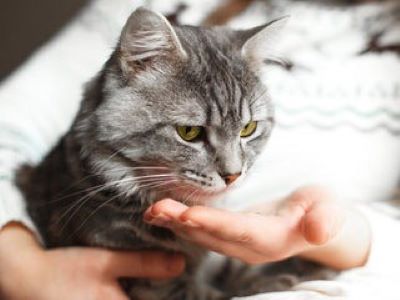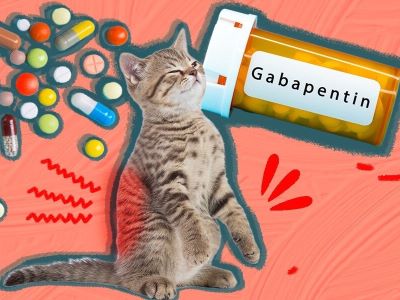The medication called gabapentin is frequently used to treat a variety of ailments in both people and animals, including anxiety, seizures, and chronic pain.
Gabapentin has a specific ability to assist cats manage neuropathic pain, which is brought on by nerve injury or dysfunction. When taking a cat to the veterinarian or in a car, gabapentin can also be used to quiet down anxious or combative cats.
How Does Gabapentin Work in Cats?
Gabapentin is a medication that can help cats with different conditions, such as chronic pain, seizures, and anxiety.
It functions by influencing the activity of specific neurotransmitters that are involved in sending pain signals and controlling mood and behavior in the brain and spinal cord.

The neurotransmitter glutamate, which stimulates nerve cells and produces pain, is released less frequently when gabapentin is taken. GABA, a neurotransmitter that inhibits nerve cells and has a calming effect, is similarly elevated by gabapentin.
Here is a brief explanation of how gabapentin works in cats for each condition:
- For chronic pain: Gabapentin blocks the calcium channels in the brain that convey pain signals to treat chronic pain, particularly nerve pain. The cat is more at ease as a result of the pain being lessened. In addition, gabapentin helps ease cancer or arthritic pain.
- For seizures: Gabapentin mimics the effects of GABA, a brain neurotransmitter that naturally regulates the excessive electrical activity that leads to seizures. In order to regulate brain activity and either prevent or lessen seizure frequency and severity, gabapentin is used.
- For anxiety: Cats who are experiencing anxiety can be calmed and sedated with gabapentin. They become less stressed, more at ease, more cooperative as a result. Cats can benefit from gabapentin to help them deal with stressful events like seeing the vet, traveling, or relocating.

Cats usually get gabapentin orally in the form of a tablet, capsule, or liquid. The frequency and amount are determined by the cat’s weight, health, and reaction to the drug. A veterinarian should always write a prescription for gabapentin so they can keep an eye on the cat’s health and change the dosage as necessary.
What Are the Benefits of Gabapentin for Cats?
Cats who suffer from a variety of diseases, including anxiety, chronic pain, and seizures, may benefit from the medicine gabapentin. Depending on the issue, it has varying effects on cats’ neurological systems and brains. The following are a few advantages of gabapentin for cats:

- Reduced anxiety and stress: Cats respond to gabapentin by becoming calm and sedated. They become less stressed, more at ease, more cooperative as a result.
Cats can benefit from gabapentin to help them deal with stressful events like seeing the vet, traveling, or relocating. Additionally, it can lessen aggression and enhance cats’ sleeping patterns.
- Pain relief: Cats who experience chronic pain, particularly nerve discomfort, can benefit from gabapentin treatment. It prevents the brain’s calcium channels from sending pain signals. The cat is more at ease as a result of the pain being lessened.
In addition, gabapentin helps ease cancer or arthritic pain. To increase the effects of other painkillers like opioids or nonsteroidal anti-inflammatory medicines, it can be used with them.
- Improved quality of life: Gabapentin helps cats live better lives and feel better by lowering their anxiety, tension, and pain. Cats on gabapentin treatment may exhibit increased social behavior, hunger, activity, and interest in their surroundings.
By reducing or eliminating seizures, which can be fatal, gabapentin can also prolong the life of cats.
What Are the Side Effects of Gabapentin for Cats?
The majority of cats tolerate gabapentin generally well, although some adverse effects, like:

- Drowsiness or sleepiness
- Lack of coordination or balance
- Vomiting or diarrhea
- Reduced appetite or weight loss
These negative effects are often brief and minor, and they may become better as the cat gets used to the drug. However, you should speak with your veterinarian right once if they continue or get worse.
What Is the Dosage of Gabapentin for Cats?
The dosage of gabapentin for cats is determined by a number of variables, including the cat’s weight, age, general health, and reaction to the medication. Based on these variables, your veterinarian will recommend the right dosage and frequency for your cat.
You should carefully follow your veterinarian’s recommendations and never alter the dosage or discontinue taking a medicine without first talking to your veterinarian.

For cats, the usual dosing range for gabapentin is 5 to 20 mg per kilogram of body weight, administered once or twice a day. Nevertheless, a cat’s specific demands might require larger or lower doses in rare instances.
How to Give Gabapentin to Your Cat?
Gabapentin is available in a variety of dosage forms, including capsules, pills, liquids, and injections. Capsules, which may be opened and combined with treats or wet food, are the most popular type for cats. You can give your cat the medication using a syringe or a pill pocket as well.

To keep a constant blood level of the drug, you should administer gabapentin to your cat at the same time each day. Additionally, avoiding feeding your cat gabapentin on an empty stomach will help ensure that medication works as intended.
FAQs
Is gabapentin safe for cats?
When used as prescribed and under a veterinarian’s supervision, gabapentin is typically safe for cats. However, some cats may experience allergic reactions or drug interactions. Before starting your cat on gabapentin, let your veterinarian know whether they are on any other drugs or supplements.
How long does gabapentin last in cats?
The dosage and ailment being treated affect how long gabapentin takes to work in cats. In cats, gabapentin’s effects on pain may last for 4 to 6 hours. In cats, gabapentin’s sedative effects might continue for 8 to 12 hours.
Can I give my cat human gabapentin?
No, you should never provide human gabapentin or any other drug to your cat without first consulting a veterinarian. Different strengths, formulations, or additions of human gabapentin may be dangerous or ineffective for cats. When your veterinarian prescribes gabapentin for your cat, you should always utilize it.
Can I stop giving my cat gabapentin if he/she seems better?
No, you shouldn’t discontinue administering gabapentin to your cat without first visiting a veterinarian. Abruptly stopping gabapentin may result in rebound effects or withdrawal symptoms.
Conclusion
Cats who are suffering from chronic pain, seizures, or anxiety may benefit from the usage of the drug gabapentin. Typically, it is taken orally as a pill, capsule, or liquid.
Depending on the ailment being treated and the cat’s unique response, the amount and frequency of delivery will vary.
Some side effects of gabapentin include vomiting, lethargy, and irregular walking. It may interfere with other medications, thus it should be taken cautiously in cats who have liver or kidney illness. Only a veterinarian should administer gabapentin since they can keep an eye on its effects and modify the course of treatment as necessary.
For cats who experience pain, seizures, or stress, gabapentin may be a useful treatment, but it is not a cure and may not be effective for all cats. As a result, it’s crucial to seek advice from your veterinarian before administering gabapentin to your cat and to carefully follow their instructions.

Brenda Castillo is a volunteer groomer of a local pet welfare group in New York and a regular contributor to CatLikesBest. She likes to read & write about cat grooming. She also guardians two chubby tabbies, Belly & Puma.

